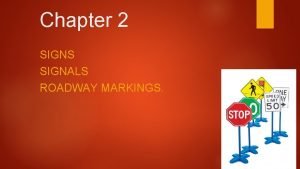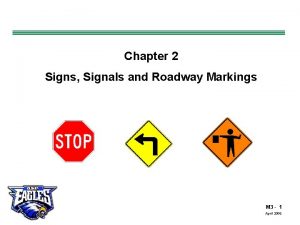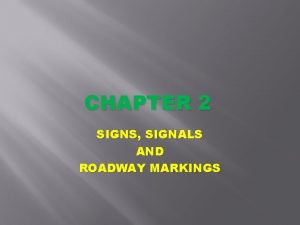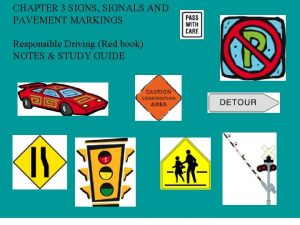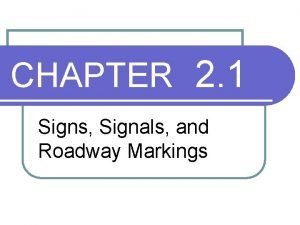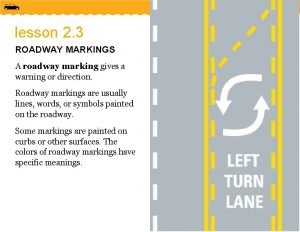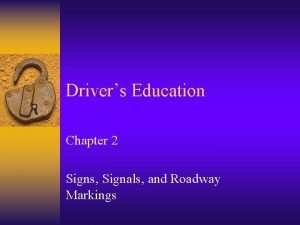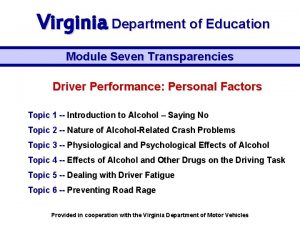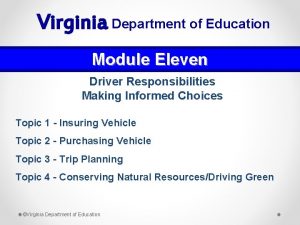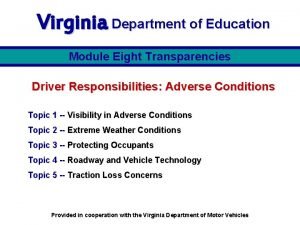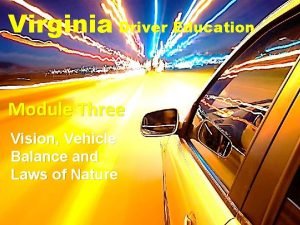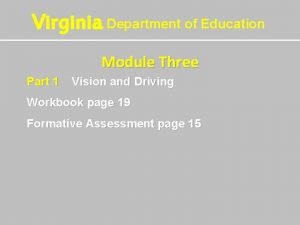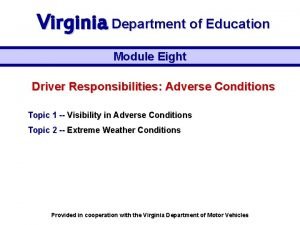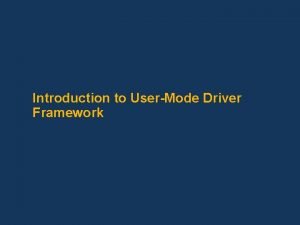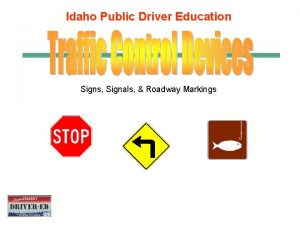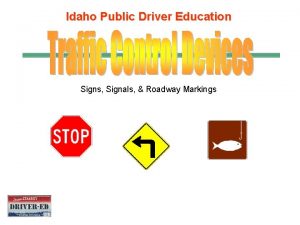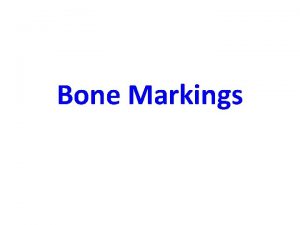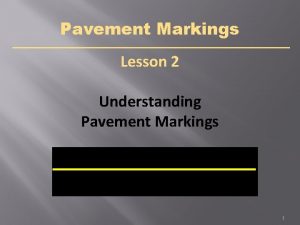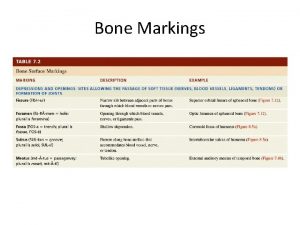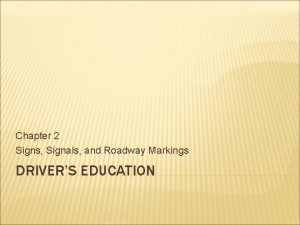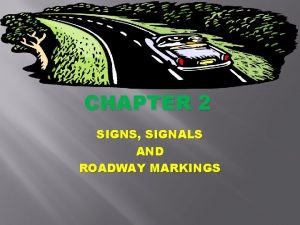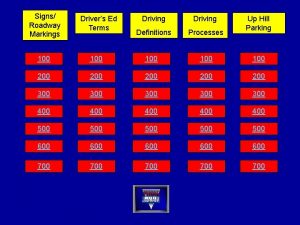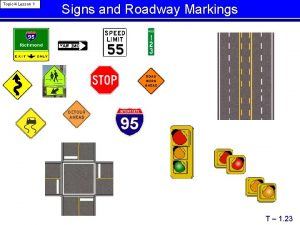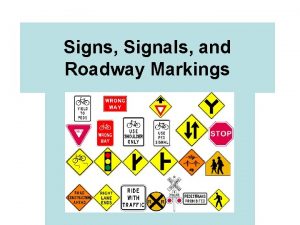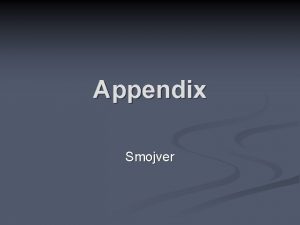Roadway Markings NV Driver Education Curriculum Unit 2



















- Slides: 19

Roadway Markings NV Driver Education Curriculum Unit 2: Signs, Signals, and Roadway Markings Presentation 3 of 3

Roadway Markings • Warn, regulate, and inform – lines, words, or symbols on the road • Marking are white and yellow – May be reflective • Type of lines have meaning – Solid and Broken

Two Colors of Lines • White lines separate traffic lanes traveling in the same direction • Yellow lines separate traffic lanes traveling in opposite directions General rule: Broken lines can be crossed and solid lines cannot (exception when making a turn)

Yellow Lines Yellow lines separate traffic lanes traveling in opposite directions Single, broken yellow line indicates may pass when safe Single, solid yellow line indicates that passing is not allowed

Single Lane Roads Two-way traffic Yellow center line may be single, double, solid, or broken (dashed) You may pass when there is a broken line on your side of the road You may not pass when there is a solid line on your side of the road

White Lines • White lines separate traffic lanes traveling in the same direction • Broken (dashed) white lines may be crossed when changing lanes • Solid white line are used in several ways, including marking edge of road. May not cross, with few exceptions: – Immediate right turns (no more than 200 ft prior) – Enter or exit HOV lane

Solid White Lines Video See LVPD Video Crossing Solid White Line http: //www. youtube. com/watch ? v=Jq 3 zn 2 Tt. Bi. A (0: 31) Click on web address to access video clips *Suggest full screen viewing NOTE: Some on - Check access

Center Lanes Shared left-turn lane • May not be used for passing • May not travel more than 200 ft before turning left • May not travel more than 50 ft after turning left before merging with traffic

White Arrows White arrows indicate a turn lane • If marked “ONLY” you must obey direction • When marked with a curve and straight arrow, you may turn or continue forward

Reversible Lanes Reversible lanes are used to improve traffic flow during rush hours • Marked by two broken yellow lines • Changes direction of travel within lane • Overhead signals indicate availability RED “X” – Lane is closed in this direction. Never drive in this lane. YELLOW “X” – Lane signal is going to change. Exit the lane safely before the red “X” appears GREEN ARROW – Lane may be used.

High-Occupancy Vehicle (HOV) Lane High-Occupancy Vehicle (HOV) lanes are restricted for vehicles with two or more people • Designed by a diamond-shape symbol • May have restricted hours

HOV Lanes Video See Nevada RTC&DOT video HOV Lanes in Las Vegas http: //www. youtube. com/watch ? v=f. Fk. RMf. MIGk 4 (2: 43) Click on web address to access video clips *Suggest full screen viewing NOTE: Some on - Check access

Highway Ramps Highway ramps use solid white lines to indicate it is dangerous and illegal to cross – Called the gore area: area between the edge of the highway and the edge of the ramp meet – May include angled or diagonal lines

Stop Lines and Crosswalks Stop lines are wide white lines where you must stop before entering an intersection or railroad crossing Crosswalks areas for pedestrians (in front of stop lines) and may include two parallel or diagonal lines.

Special Lanes Bike lanes – Designated by striping and signing – If line is broken may cross if clear Bus lanes – Used to speed up public transport – Some cities may allow taxis – May have time designations

Raised Pavement Markers Reflective Markers (may or may not be raised) like white and yellow lines - mark lanes of travel – White markers used between lanes or edge of road – Red markers warn drivers going the wrong direction – Yellow markers found on left edge of expressways – Blue markers identify the location of a fire hydrant

Other Pavement Markings Rumble strips – Grooved or corrugated roadway, causes vibration and loud noise when drive over Speed bumps and dips – Used to slow traffic speed – Should drive slowly over bumps and through dips

Other Roadway Markings Lines, words, and symbols found on the pavement

Did You Know • Both Michigan (1911) and California (1917) claim to be the first to develop center road lines. • White center lines were used in the U. S. until 1971, when yellow became the mandated standard. White center lines are used in Canada, Great Britain, and many other countries.
 Special roadway markings
Special roadway markings Fluorescent optic yellow sign meaning
Fluorescent optic yellow sign meaning Traffic sign color meanings
Traffic sign color meanings What are six types of special roadway mark- ings?
What are six types of special roadway mark- ings? A traffic-control officer’s signal
A traffic-control officer’s signal Guide and international signs
Guide and international signs Chapter 2 signs, signals, and roadway markings
Chapter 2 signs, signals, and roadway markings Red raised roadway marker
Red raised roadway marker Drivers ed chapter 2 signs signals and roadway markings
Drivers ed chapter 2 signs signals and roadway markings Module 10 drivers ed virginia
Module 10 drivers ed virginia Drivers ed module 7
Drivers ed module 7 Module 11 topic 1 insuring a vehicle
Module 11 topic 1 insuring a vehicle Curriculum guide for driver education in virginia module 8
Curriculum guide for driver education in virginia module 8 Module 3 topic 2 vision and driving
Module 3 topic 2 vision and driving Standard 4 part 1 a: vehicle balance & control
Standard 4 part 1 a: vehicle balance & control The 3 parts to a curve are the entrance, apex, and exit.
The 3 parts to a curve are the entrance, apex, and exit. Module 8 topic 1
Module 8 topic 1 User mode driver framework
User mode driver framework Montana driver education
Montana driver education Driver education signs
Driver education signs
